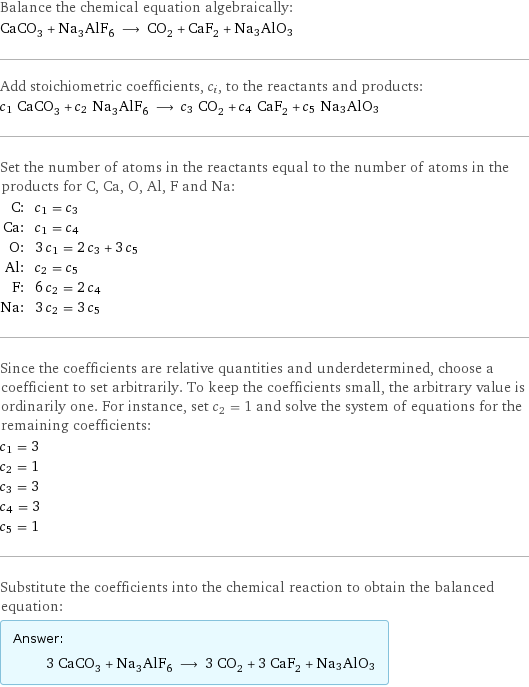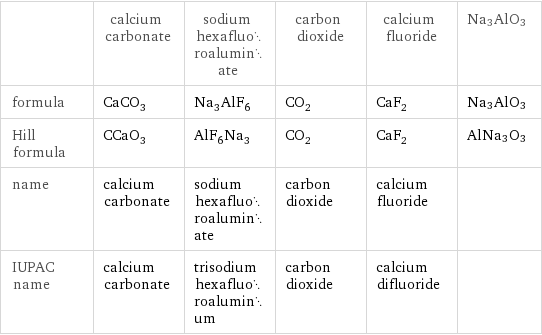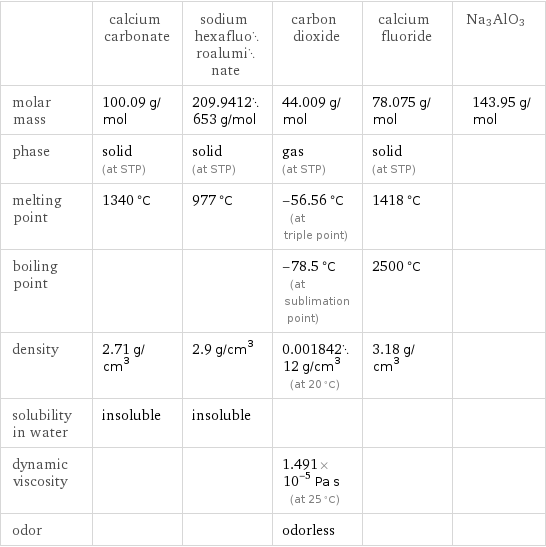Input interpretation

CaCO_3 calcium carbonate + Na_3AlF_6 sodium hexafluoroaluminate ⟶ CO_2 carbon dioxide + CaF_2 calcium fluoride + Na3AlO3
Balanced equation

Balance the chemical equation algebraically: CaCO_3 + Na_3AlF_6 ⟶ CO_2 + CaF_2 + Na3AlO3 Add stoichiometric coefficients, c_i, to the reactants and products: c_1 CaCO_3 + c_2 Na_3AlF_6 ⟶ c_3 CO_2 + c_4 CaF_2 + c_5 Na3AlO3 Set the number of atoms in the reactants equal to the number of atoms in the products for C, Ca, O, Al, F and Na: C: | c_1 = c_3 Ca: | c_1 = c_4 O: | 3 c_1 = 2 c_3 + 3 c_5 Al: | c_2 = c_5 F: | 6 c_2 = 2 c_4 Na: | 3 c_2 = 3 c_5 Since the coefficients are relative quantities and underdetermined, choose a coefficient to set arbitrarily. To keep the coefficients small, the arbitrary value is ordinarily one. For instance, set c_2 = 1 and solve the system of equations for the remaining coefficients: c_1 = 3 c_2 = 1 c_3 = 3 c_4 = 3 c_5 = 1 Substitute the coefficients into the chemical reaction to obtain the balanced equation: Answer: | | 3 CaCO_3 + Na_3AlF_6 ⟶ 3 CO_2 + 3 CaF_2 + Na3AlO3
Structures

+ ⟶ + + Na3AlO3
Names

calcium carbonate + sodium hexafluoroaluminate ⟶ carbon dioxide + calcium fluoride + Na3AlO3
Equilibrium constant
![Construct the equilibrium constant, K, expression for: CaCO_3 + Na_3AlF_6 ⟶ CO_2 + CaF_2 + Na3AlO3 Plan: • Balance the chemical equation. • Determine the stoichiometric numbers. • Assemble the activity expression for each chemical species. • Use the activity expressions to build the equilibrium constant expression. Write the balanced chemical equation: 3 CaCO_3 + Na_3AlF_6 ⟶ 3 CO_2 + 3 CaF_2 + Na3AlO3 Assign stoichiometric numbers, ν_i, using the stoichiometric coefficients, c_i, from the balanced chemical equation in the following manner: ν_i = -c_i for reactants and ν_i = c_i for products: chemical species | c_i | ν_i CaCO_3 | 3 | -3 Na_3AlF_6 | 1 | -1 CO_2 | 3 | 3 CaF_2 | 3 | 3 Na3AlO3 | 1 | 1 Assemble the activity expressions accounting for the state of matter and ν_i: chemical species | c_i | ν_i | activity expression CaCO_3 | 3 | -3 | ([CaCO3])^(-3) Na_3AlF_6 | 1 | -1 | ([Na3AlF6])^(-1) CO_2 | 3 | 3 | ([CO2])^3 CaF_2 | 3 | 3 | ([CaF2])^3 Na3AlO3 | 1 | 1 | [Na3AlO3] The equilibrium constant symbol in the concentration basis is: K_c Mulitply the activity expressions to arrive at the K_c expression: Answer: | | K_c = ([CaCO3])^(-3) ([Na3AlF6])^(-1) ([CO2])^3 ([CaF2])^3 [Na3AlO3] = (([CO2])^3 ([CaF2])^3 [Na3AlO3])/(([CaCO3])^3 [Na3AlF6])](../image_source/33d8ca5e1057e52170c82cf9ffd4b772.png)
Construct the equilibrium constant, K, expression for: CaCO_3 + Na_3AlF_6 ⟶ CO_2 + CaF_2 + Na3AlO3 Plan: • Balance the chemical equation. • Determine the stoichiometric numbers. • Assemble the activity expression for each chemical species. • Use the activity expressions to build the equilibrium constant expression. Write the balanced chemical equation: 3 CaCO_3 + Na_3AlF_6 ⟶ 3 CO_2 + 3 CaF_2 + Na3AlO3 Assign stoichiometric numbers, ν_i, using the stoichiometric coefficients, c_i, from the balanced chemical equation in the following manner: ν_i = -c_i for reactants and ν_i = c_i for products: chemical species | c_i | ν_i CaCO_3 | 3 | -3 Na_3AlF_6 | 1 | -1 CO_2 | 3 | 3 CaF_2 | 3 | 3 Na3AlO3 | 1 | 1 Assemble the activity expressions accounting for the state of matter and ν_i: chemical species | c_i | ν_i | activity expression CaCO_3 | 3 | -3 | ([CaCO3])^(-3) Na_3AlF_6 | 1 | -1 | ([Na3AlF6])^(-1) CO_2 | 3 | 3 | ([CO2])^3 CaF_2 | 3 | 3 | ([CaF2])^3 Na3AlO3 | 1 | 1 | [Na3AlO3] The equilibrium constant symbol in the concentration basis is: K_c Mulitply the activity expressions to arrive at the K_c expression: Answer: | | K_c = ([CaCO3])^(-3) ([Na3AlF6])^(-1) ([CO2])^3 ([CaF2])^3 [Na3AlO3] = (([CO2])^3 ([CaF2])^3 [Na3AlO3])/(([CaCO3])^3 [Na3AlF6])
Rate of reaction
![Construct the rate of reaction expression for: CaCO_3 + Na_3AlF_6 ⟶ CO_2 + CaF_2 + Na3AlO3 Plan: • Balance the chemical equation. • Determine the stoichiometric numbers. • Assemble the rate term for each chemical species. • Write the rate of reaction expression. Write the balanced chemical equation: 3 CaCO_3 + Na_3AlF_6 ⟶ 3 CO_2 + 3 CaF_2 + Na3AlO3 Assign stoichiometric numbers, ν_i, using the stoichiometric coefficients, c_i, from the balanced chemical equation in the following manner: ν_i = -c_i for reactants and ν_i = c_i for products: chemical species | c_i | ν_i CaCO_3 | 3 | -3 Na_3AlF_6 | 1 | -1 CO_2 | 3 | 3 CaF_2 | 3 | 3 Na3AlO3 | 1 | 1 The rate term for each chemical species, B_i, is 1/ν_i(Δ[B_i])/(Δt) where [B_i] is the amount concentration and t is time: chemical species | c_i | ν_i | rate term CaCO_3 | 3 | -3 | -1/3 (Δ[CaCO3])/(Δt) Na_3AlF_6 | 1 | -1 | -(Δ[Na3AlF6])/(Δt) CO_2 | 3 | 3 | 1/3 (Δ[CO2])/(Δt) CaF_2 | 3 | 3 | 1/3 (Δ[CaF2])/(Δt) Na3AlO3 | 1 | 1 | (Δ[Na3AlO3])/(Δt) (for infinitesimal rate of change, replace Δ with d) Set the rate terms equal to each other to arrive at the rate expression: Answer: | | rate = -1/3 (Δ[CaCO3])/(Δt) = -(Δ[Na3AlF6])/(Δt) = 1/3 (Δ[CO2])/(Δt) = 1/3 (Δ[CaF2])/(Δt) = (Δ[Na3AlO3])/(Δt) (assuming constant volume and no accumulation of intermediates or side products)](../image_source/8ceae291e46679def5c07b3a9944f6f8.png)
Construct the rate of reaction expression for: CaCO_3 + Na_3AlF_6 ⟶ CO_2 + CaF_2 + Na3AlO3 Plan: • Balance the chemical equation. • Determine the stoichiometric numbers. • Assemble the rate term for each chemical species. • Write the rate of reaction expression. Write the balanced chemical equation: 3 CaCO_3 + Na_3AlF_6 ⟶ 3 CO_2 + 3 CaF_2 + Na3AlO3 Assign stoichiometric numbers, ν_i, using the stoichiometric coefficients, c_i, from the balanced chemical equation in the following manner: ν_i = -c_i for reactants and ν_i = c_i for products: chemical species | c_i | ν_i CaCO_3 | 3 | -3 Na_3AlF_6 | 1 | -1 CO_2 | 3 | 3 CaF_2 | 3 | 3 Na3AlO3 | 1 | 1 The rate term for each chemical species, B_i, is 1/ν_i(Δ[B_i])/(Δt) where [B_i] is the amount concentration and t is time: chemical species | c_i | ν_i | rate term CaCO_3 | 3 | -3 | -1/3 (Δ[CaCO3])/(Δt) Na_3AlF_6 | 1 | -1 | -(Δ[Na3AlF6])/(Δt) CO_2 | 3 | 3 | 1/3 (Δ[CO2])/(Δt) CaF_2 | 3 | 3 | 1/3 (Δ[CaF2])/(Δt) Na3AlO3 | 1 | 1 | (Δ[Na3AlO3])/(Δt) (for infinitesimal rate of change, replace Δ with d) Set the rate terms equal to each other to arrive at the rate expression: Answer: | | rate = -1/3 (Δ[CaCO3])/(Δt) = -(Δ[Na3AlF6])/(Δt) = 1/3 (Δ[CO2])/(Δt) = 1/3 (Δ[CaF2])/(Δt) = (Δ[Na3AlO3])/(Δt) (assuming constant volume and no accumulation of intermediates or side products)
Chemical names and formulas

| calcium carbonate | sodium hexafluoroaluminate | carbon dioxide | calcium fluoride | Na3AlO3 formula | CaCO_3 | Na_3AlF_6 | CO_2 | CaF_2 | Na3AlO3 Hill formula | CCaO_3 | AlF_6Na_3 | CO_2 | CaF_2 | AlNa3O3 name | calcium carbonate | sodium hexafluoroaluminate | carbon dioxide | calcium fluoride | IUPAC name | calcium carbonate | trisodium hexafluoroaluminum | carbon dioxide | calcium difluoride |
Substance properties

| calcium carbonate | sodium hexafluoroaluminate | carbon dioxide | calcium fluoride | Na3AlO3 molar mass | 100.09 g/mol | 209.9412653 g/mol | 44.009 g/mol | 78.075 g/mol | 143.95 g/mol phase | solid (at STP) | solid (at STP) | gas (at STP) | solid (at STP) | melting point | 1340 °C | 977 °C | -56.56 °C (at triple point) | 1418 °C | boiling point | | | -78.5 °C (at sublimation point) | 2500 °C | density | 2.71 g/cm^3 | 2.9 g/cm^3 | 0.00184212 g/cm^3 (at 20 °C) | 3.18 g/cm^3 | solubility in water | insoluble | insoluble | | | dynamic viscosity | | | 1.491×10^-5 Pa s (at 25 °C) | | odor | | | odorless | |
Units
